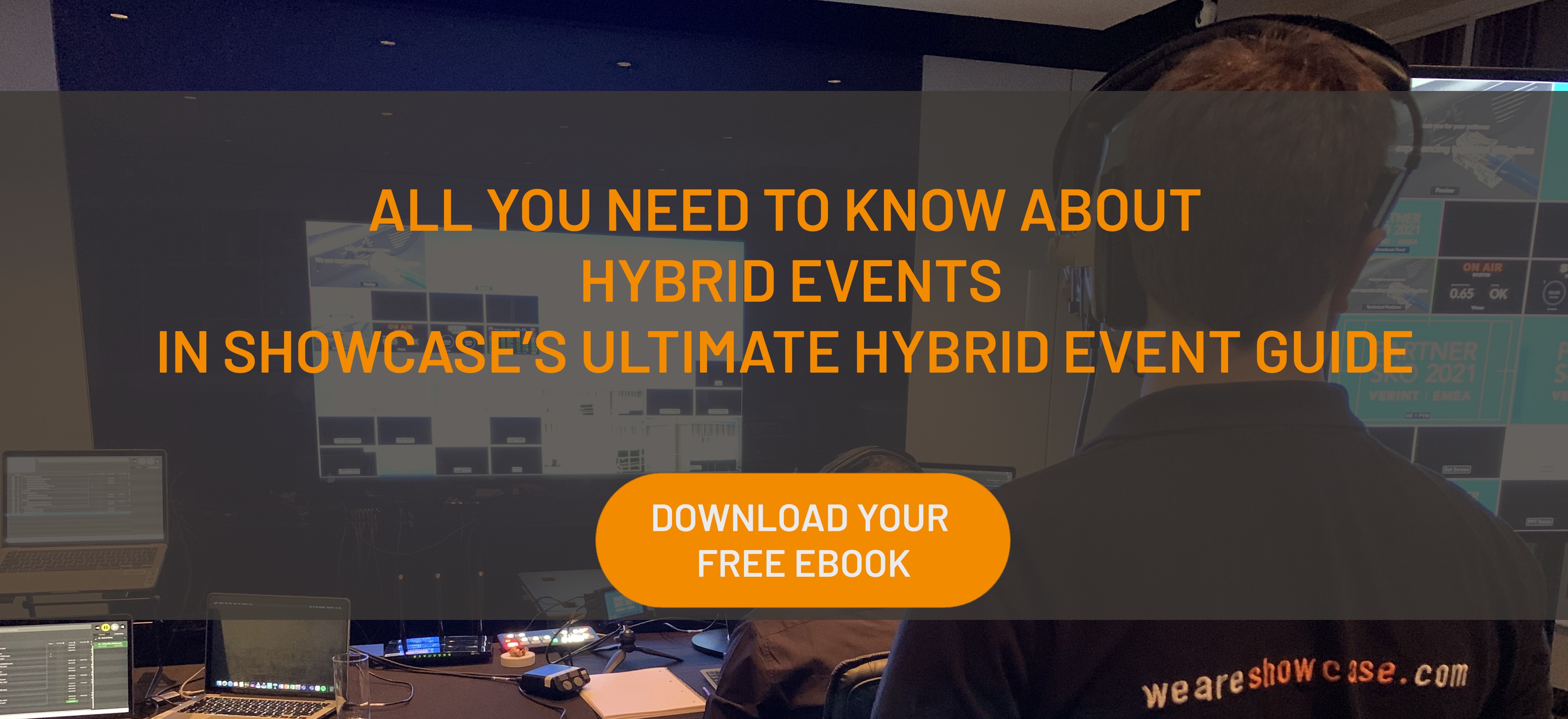Hybrid event popularity will be stretching beyond the COVID-19 era – and that’s a fact. The format born as an industry’s response to hindering restrictions unites all the things we love about events: creativity, flexibility and engineering excellence. Hybrid events are not a temporary solution – they are a vital next step in event evolution even after live events return.
If you plan to host a hybrid event – beware. There are two challenges:
1) Tailoring a programme to engage two audiences simultaneously and
2) Ensuring that the content is delivered in an engaging manner – this responsibility falls upon Event and Ops Directors.
Tech-Prep for a Hybrid Event
Catering for two audiences calls for double prep. While content undoubtedly lays in the foundation of the event, it’s delivery that drives the engagement and dictates the overall success.
Communication is the key to a successful hybrid event – but you already know that. With 2021 being as hectic as it is, it’s nice to have a quick handbook on technical hybrid event prep. You have worked your way through a global pandemic and we want to give you a go-to guide that makes things a little easier.
Reinforcing Your Team
We have no doubt that your physical event planning team are absolute stars. They know what they’re doing and have a proven track record of successfully executing top notch events. However, on a journey that is a hybrid event they’ll need new companions – a group of people capable of taking charge of the online portion, such as setting the virtual stage up.
An A/V professional is vital for all things streaming. You also want to onboard a digital backstage guru to guide your guest speakers towards going live on the virtual stage. Finally, another addition to the team will be a person in charge of the virtual attendee engagement: strategising the pauses for interactions, sparking up the conversations and keeping the discussion going. These new roles will allow your team to broaden its horizons in terms of effective delivery, offering their expertise to the areas your team may not be as advanced in.
The Gear
Bridging the gap between on-site and virtual audiences to create equally engaging experiences will require extra equipment. To get a better idea of what gear will be needed, pore over the agenda with a fine tooth comb.
Will this be a panel discussion or an event that requires close-ups? Do you need more than two angles? These and other questions based on what you aim to deliver will help you determine what type of equipment you need.
Here’s a small list of absolute must-haves:
- Cameras
- Tripods
- Microphones
- Video switching
- Webcasting equipment
- Lighting
- Sound
- Virtual event platform

Virtual Event Platform
Same as the physical part of an event needs a venue to run, a virtual counterpart needs a platform to facilitate it. A virtual event platform such as Showcase’s Event@ is where virtual attendees access the event and virtual components such as chat, connect with the on-site audience and each other, ask questions, and otherwise engage with the event.
A virtual event platform is what allows tailoring unique online experiences for the off-site audience, keeping them included and engaged. Polls, voting, question submission, chat rooms and other functions found on Event@ will make your virtual guests feel cared about – and part of the action.
Capture the Spirit of the Event
You must have noticed we mostly talk about catering to online participants.
That’s because attending the event in-person already brings a lot of benefits that cannot be provided as effectively in a virtual environment, such as personal connections. (And because we know you’re more than capable of delivering breathtaking in-person experiences).
The main advantage of a hybrid type of event over virtual is that it can broaden your audience and exposure, providing a richer experience for everyone involved. The key is to tie two audiences together through different means of communication.
Plan Ahead
You are in charge of designing an agenda that addresses both of your audiences, keeping the program engaging and effective. Here are some questions for event planners to ask when putting together a hybrid event agenda:
- What kind of exclusive experiences will you offer?
- Will you have different sessions for virtual versus in-person attendees?
- If yes, what will make those physical and online experiences different?
- How many sessions will you host per day?
- How long will your sessions run?
Answering these key questions will enable you to come up with a programme where you attend to the needs of all your attendees: virtual and in-person. Additionally, it will give you clear insights on what equipment is needed and help map out the best way to achieve your goals and objectives.
Get the Space Ready
While preparation of the on-site setup is important, your input and expertise in live streaming is what will bridge the gap between two audiences. Creation of assets such as custom background layers, bumpers and lower thirds are the details that contribute towards translating in-person atmosphere to digital visitors.
Additionally, map out what components are going to be held real-time and which are to be pre-recorded. Then set up the time they will be delivered to the audience. A clear overview of content agenda and placement makes it easier to tie it all together into a consistent, successful event.
Work together on creating a seamless experience for both audiences. Incorporate autocue built onto the camera and adjust the focal point to where you need the speaker to stand. All in all, put your expertise together to make both virtual and online studio space have the same look and feel.
Asset Creation
All visuals that accompany the virtual part of the hybrid event must stay in line with the tone and mood of the event.
EDs and ODs working side-by-side on assets like video sting, adverts and break content will result in consistency of content delivery across all channels. Extra effort put into tailoring the virtual experience also shows the online audience they’re not being treated like second-class citizens.
Summary
Hybrid events deliver both new challenges and opportunities. Although there is a lot of planning and work going into keeping two audiences equally engaged, it pays off well when done right.
Although the pandemic is widely perceived to have a negative impact on the event industry, we are firm in our stance that it was a push needed to evolve. This past year has changed our views on technical capacities and made us re-evaluate the content and communication with both the audience and internally. Such a shift of a thought process discovered new opportunities and benefits of hybrid events.
What are your thoughts on the matter? We would love to have a further discussion.


